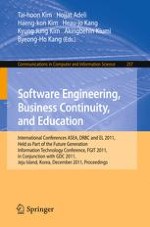2011 | Buch
Software Engineering, Business Continuity, and Education
International Conferences ASEA, DRBC and EL 2011, Held as Part of the Future Generation Information Technology Conference, FGIT 2011, in Conjunction with GDC 2011, Jeju Island, Korea, December 8-10, 2011. Proceedings
herausgegeben von: Tai-hoon Kim, Hojjat Adeli, Haeng-kon Kim, Heau-jo Kang, Kyung Jung Kim, Akingbehin Kiumi, Byeong-Ho Kang
Verlag: Springer Berlin Heidelberg
Buchreihe : Communications in Computer and Information Science
